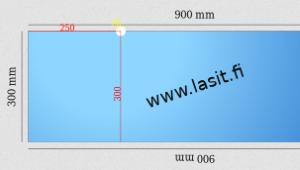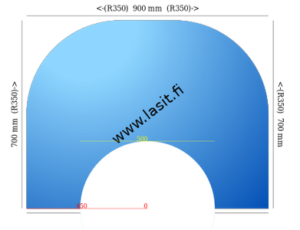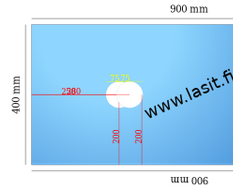Borofloat
Borosilicate glass (borofloat, borosilicate flat glass)
Borosilicate glass, most common applications: technical applications requiring better resistance to heat (max +500 Celsius < 10 hours or +450 Celsius more than 10 hours, maximum temperature difference inside the glass 300K) or acidic or alkaline substances, e.g. inspection hatch glass, 3D printer levels, etc. # borofloat price
Borosilicate glass has a harder surface than ordinary float glass, which means that it also has better wear resistance and mechanical resistance than ordinary float glass.
Borosilicate glass is clear and more colourless than ordinary construction glass.
We have the following borosilicate flat glasses in stock:
- Schott Borofloat 2.0mm
- Thickness tolerance -+0.05mm
- Schott Borofloat 3.8mm
- Thickness tolerance -+0.2mm
- Schott Borofloat 6.5mm
- Thickness tolerance -+0.2mm
- Schott Borofloat 11mm
- Thickness tolerance -+0.3mm
- Schott Borofloat 15mm
- Thickness tolerance -+0.4mm
- Schott Borofloat 19mm
- Thickness tolerance -+0.5mm
Note! For the outer dimensions of borosilicate glass made to specification, we use the normal dimensional tolerances for building glass in accordance with our delivery terms. If you need glass made to any other dimensional tolerance (e.g. +-0.7, +-0.5 or +-0.1 etc.), please contact our sales department.
Schott Borofloat glass
- thermal properties (PDF)
- mechanical properties (PDF)
- optical characteristics (PDF)
- chemical properties (PDF)
- general characteristics (PDF)
Borosilicate glass is not suitable for fireplace glass. Suitable glass for fireplaces is ceramic fire-resistant glass.
Edge treatment (arrising, grinding, polishing..)
If the edges of the glass remain visible after installation, we recommend that you also apply a edge polish to the glass from the edges menu. In this case, the sharp edges of the glass are grinded clean and polished. ready for presentation. Edge grinding also slightly increases the bending resistance of the glass. To add to the appearance, you can also choose to have the glass surface faceted at the edge or 45-degree faceted. When facet grinding glasses, if all corners of the glass are rounded with less than 11mm of angular curvature, the facet grinding is done in a straight line and does not follow the angular curvature. Otherwise, the facet is performed on a CNC machine to follow the edge line of the glass, including the rounding.
When ordering borosilicate glass - if you do not choose edge grinding (cut only), we will in any case roughly strip the edges of the glass to blunt the sharp edges.
You can get borosilicate glasses cut to any of the above glass shapes (select shape), also available with holes drilled.
If you need radius corners - Examples of the size of radiuses: R or radius, which is the size of the circle the angular rotation is part of. Examples of what corner spinning can be compared to:
- The diameter of a long-playing LP is about 300mm, i.e. radius R=150mm
- The diameter of the CD is 120mm, i.e. radius R=60mm
- The diameter of a 2 euro coin is about 25mm, i.e. radius R=12.5mm
- The diameter of a 10 ct coin is about 20mm, i.e. radius R=10mm
- 3mm rounding (R3) the rounding is just visible to the eye from the corner of the round, but the shape of the glass is not yet substantially changed
- The 1mm rounding (R1) doesn't look much like a rounded corner, but feeling it with your fingertip you can feel that the sharpness has just about disappeared.
Drilling a hole in the glass - you can also order holes to be drilled in the glass to your desired location. There are certain regularities in where holes can be drilled in the glass. For example, each glass thickness has its own minimum distances, the distance between the edge of a hole and, for example, the edge of the glass, the corner of the glass or another hole. These distances are larger in tempered glass than in untempered glass, and the distances increase with the thickness of the glass. There is also a minimum hole diameter depending on the glass thickness.
- Our calculator always automatically checks that these minimum distances are met and that the hole is not too small for the glass thickness.
- The holes are always rough-edged, i.e. the holes are supposed to go "hidden".
- 6-40mm holes are usually drilled with diamond drills and holes over 40mm are either drilled or machined with CNC machines.
- There is no upper limit to the size of the hole, we can machine almost any size hole in the glass
- The holes can also be flush with the edges, i.e. make a so-called. half e.g. for cable penetrations, etc. or fireplace glass against a round fireplace


- The holes cannot be too close together, but the holes can partially overlap (min 1/3 part) - this will give you longer gaps. (Hole spacers may be machined straight if production possibilities so require)

- If possible, always try to use the same hole size (cheaper)
Please note that borosilicate glass cannot temper (tempering occurs at high temperatures), so if you order glass with holes, you should be careful when tightening screws through the holes, for example.
If you have any questions, please contact customer services. We are happy to help!
# borofloat price price # schott borofloat 33
# borofloat
Click on a product below to access the price calculator
Showing the single result



